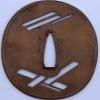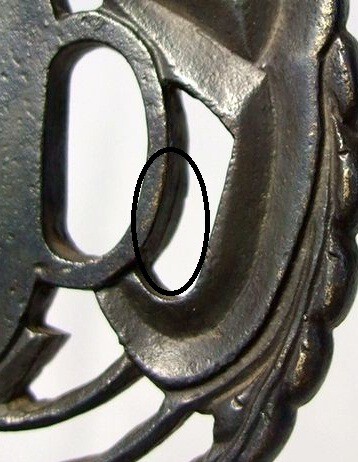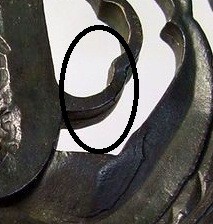-
Posts
867 -
Joined
-
Last visited
-
Days Won
2
Content Type
Profiles
Forums
Events
Store
Downloads
Gallery
Posts posted by Lee Bray
-
-
Thanks, chaps.
I would have said that machi-okuri would not affect an ubu nakago since the sabigiwa(rust border between habakimoto and nakago) separates the nakago from the blade to me.
But if the NTHK say that a nakago is not ubu because of a 1cm machi-okuri...fair enough.
-
An orikaeshi mei blade still has its mei but is far from ubu.
A Koto tachi nijimei with the kanji just above the jiri...that retains its mei but is not ubu.
Just because the mei is present doesn't mean the nakago is ubu.
Would machi-okuri be regarded as an alteration of the nakago and make it not ubu?
-
I think he means a gimei of the Kamakura period Ryokai, son of Rai Kunitoshi.
-
Mark - if it is forge scale on your tang then the tang will have been heated to such a degree that the hamon in the blade will be adversely affected.
I'd be hoping it is pine resin or some other glue residue if I were you.
-
I'll see if I can lower it down to $50, repolish it, and use it for rough backyard tameshigiri.
The steel in Chinese fakes is cheap, of unknown quality and has no heat treatment.
'Backyard tameshigiri', any kind of cutting and possibly even just swinging it will more than likely result in a broken blade and worst case scenario, the broken bit is lodged in you or anyone with you.
Save your money and some probable grief.
-
The above Yasuoki has been returned to the Hong Kong owner with no problems.
It was held in customs and returned by them, never making it to the Tokyo dealer.
The dealer has since said that for swords made less than 100 years ago he needs the details first, then he can apply for an entry permit for the sword and proceed as normal.
I believe this is also the case for hand carried swords as a respected US polisher had issues hand carrying a Gassan(less than 100 years old, don't know which Gassan) blade into Japan at the same time as the Yasuoki incident.
He actually managed to get it through but had to pay an import tax and was told he would no longer be able to bring in modern swords without the necessary paperwork.
-
I just had a Gendaito tsuka wrapped by David.
Great work, good price and easy to deal with. I'd recommend him and will certainly use him again myself.
-
Depends on the amount of carbon and the heat treatment. You can harden steel so that it is not brittle....
Isn't that just tempering, reducing the hardness with heat?
I'm wondering why high carbon steel would be considered for a tsuba. High carbon steel would have been reserved for swords.
It makes little sense to me that HC steel would be used in tsuba but maybe it was.
Henk - Of course it's brittle otherwise it wouldn't chip, it would roll.
-
Hardened steel is brittle. Unhardened steel is tough and malleable.
Why any warrior would want a hardened, high carbon tsuba next to his fingers is beyond me.
-
Thanks for the explanation, Chris.
O MiMi's knowledge is second to none so food for thought.
I'm not entirely convinced though, as it still seems to me that compete carbon migration would negate any value of soft core steel to hard edge steel.
-
Hi Chris,
Carbon diffusion takes place at welding heat but not to the degree that the entire piece is homogenous otherwise what would be the point of shingane, kawagane and hagane in a sword?
Edit - I just noticed your use of the word 'local' which could invalidate my point but then recall the So Tsutomu hamon. There was a clear demarcation between the two different carbon content steels and they reached welding heat.
-
-
Hi Christian - Perhaps Dr. Hoopes was working from incorrect material as I believe Nihonto are tempered(yaki-modoshi) after quenching(yaki-ire). It is outlined in Yoshihara's "The Craft of the Japanese Sword" on page 92.
David, I believe Ford's comments meant that if some tsuba were hardened, it would be very difficult to add sekigane or hitsuana at any time after they were made. Any work to fit the tsuba to another sword would be almost impossible if the tsuba steel was hardened to any degree. Files don't cut, saw blades don't cut and punches would have a hard time moving hardened steel.
It seems to make little sense to harden tsuba steel.
-
Might this characteristic been the result of a re-tempering? F
If you're thinking that the higher hamon is a 'ghost' of the former hamon prior to re-tempering, that's not the case.
A sword would be annealed prior to yaki-naoshi and any former hamon would disappear as a result.
Even if it wasn't annealed, the temperature reached in yaki-naoshi would wipe out the former hamon.
If that's not what you're thinking...my apologies.

-
Tsuruta-san states at the bottom of the blurb, "This sword was made a copy of Kiyomaro."
Regarding the 'double hamon' - are we looking at honsanmai construction using a higher carbon steel on the side(kawagane) than normal?
High enough carbon that hardens during heat treatment as opposed to a low carbon steel on the side that would stay soft.
The nie seems to follow the internal 'hamon' line, so this is the hard edge steel(hagane). A low carbon kawagane would not harden and the border where the two steels meet blends into the hada(or can be seen as a faint colour change in the steel in some swords that use honsanmai). A higher carbon kawagane would harden, especially with the higher heat treat temperatures used to create nie(if my thinking is correct) and that is what we're seeing here. Slightly lower carbon kawagane than hagane and you'd get nie in the hagane and none in the kawagane if your heat treat control was precise.
-
I can confirm the sword was a signed and dated Yasuoki and was sent to a long established dealer in Tokyo by a chap in Hong Kong.
The agent was told the rules had changed and blades less than a century old were not allowed in. The agent relayed this back to the sender.
As of yet, I'm not sure if the sword has been held or shipped back.
Hopefully, just an ignorant official, as you say, but it would be good to get the full story.
-
No great diatribe, no long point-for-point comment, just the simple statement "Chris Bowen is right on the money. Any other opinion is delusional bordering on willfully ignorant".

-
Those who have never been involved in metal work,never had a forge and forge welded,polished a blade , made and lacquered saya's or had little money should hesitate in this internet age from posting ill informed comments.

Yet you're suggesting that these same people rub diamond paste on a 3ft razor?
Sensible... :D
-
Jean,
You're correct.
I got my info from Hawley, which lists Muramasa 3 as working from 1521-32 and the first two generations as much earlier.
-
Late Muromachi, I say Muramasa 3rd.
-
Every single book I've read says that the beauty of Japanese sword is inseparable from its functionality.
Disrespectfull as I am - it's hard to believe it is so.
For many, the beauty of the Japanese sword lies in its graceful curved shape, the pattern of the steel grain and the hamon.
These are all vitally important to the functionality of the sword; the curve facilitates cutting, the hada a product of improving the initially poor(prior to forging) steel quality, and the hamon a product of the differential hardening which was needed to create the soft spine for resilience and the hard edge for staying sharp in use.
So with that said, what is it you don't believe?
So my question is, as a newbie - what should I be looking for in a sword to call it a true work of art?As a newbie, I think you're reaching a long way to call anything a true work of art. In any field of interest.
Newbies cannot make that call. As a newbie myself, I do not feel educated enough to call any Japanese sword a true work of art.
Sure, there are plenty of blades that I like and that I feel are more 'artistic' than other blades, but I'm not qualified enough to make that call.
-
-
Hi Tobias,
I've bought from Candelaria(ebay) before and the deal was flawless.
With the Owazamono name common to both sources, I suspect they are one and the same and perfectly legitimate.
But, as Grey says, contact them for peace of mind.
If you run a search for Nara Toshishige on google(web, not image), you'll find four or five examples of his mei and also one on this forum of a set I own that I posted in the translation section.
Here's a papered example from Bushiart.com - http://www.bushiart.com/shop/NI.asp?pag ... &menuName=
There seems to be some small variance in all his mei. The set on Owazamono.com/ebay has a wayward Toshi kanji compared to the other examples but the workmanship seems very similar and of good quality.
Your money, your call.

-
Bushu Ju Kanenaga









Fundo ?
in General Nihonto Related Discussion
Posted
Is this a Japanese fundo?
I came by it in Hong Kong several years ago and assumed it was a large, Chinese paper weight or scale weight. Recently, though, I saw a tsuba on RichT's blog which pictured a set of fundo which are identical in shape.
It's made of either brass or bronze and weighs 1115.7g so doesn't correlate with any Japanese weight units. I believe 2 kin weigh 1.2kg and although it's had a few divots taken out of it, it's a bit of a stretch to think it's lost 84.3g...although it could have belonged to an unscrupulous merchant who liked light weights...(who ever heard of such a thing )
)
There also appear to be 3 or 4 kanji/hanzi on the top. Too much abuse to read them but the top could be Kin.
Thanks for any information.